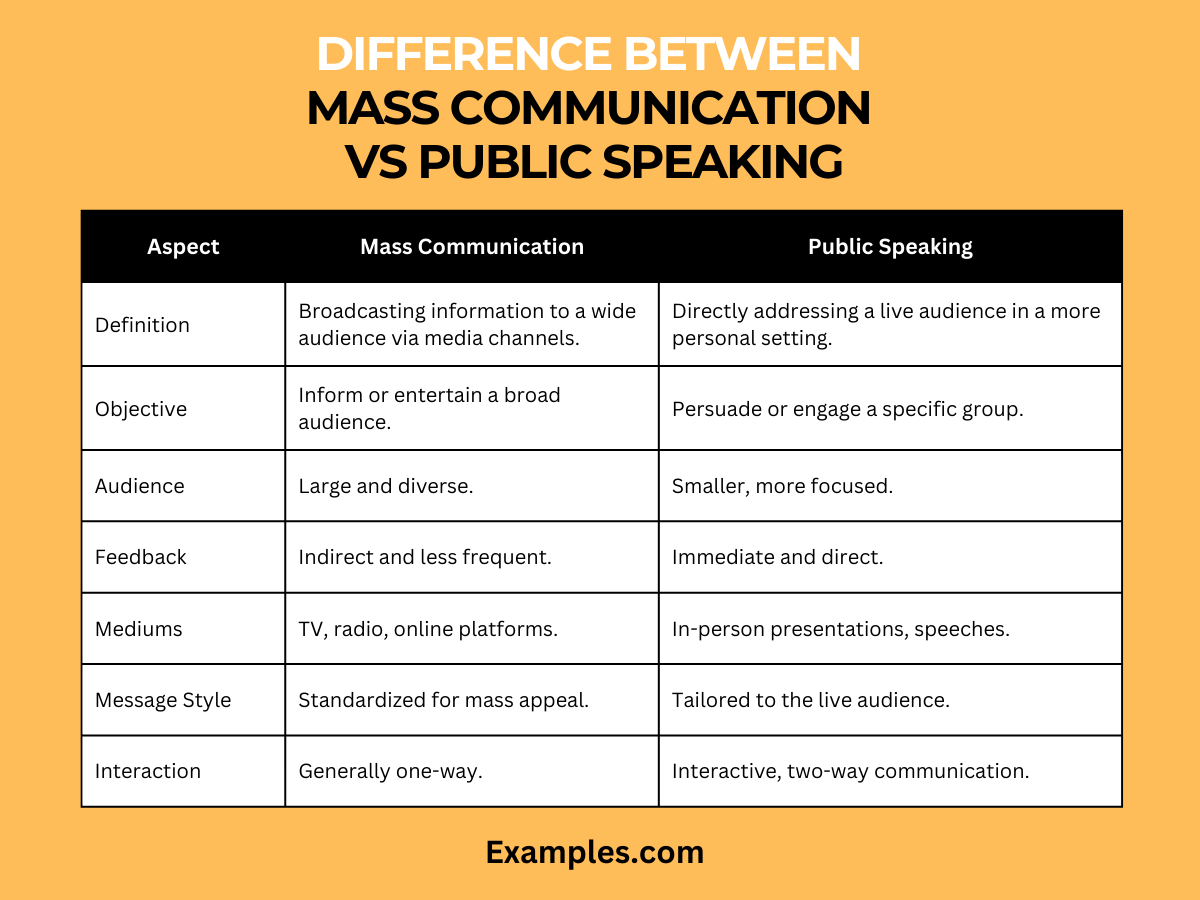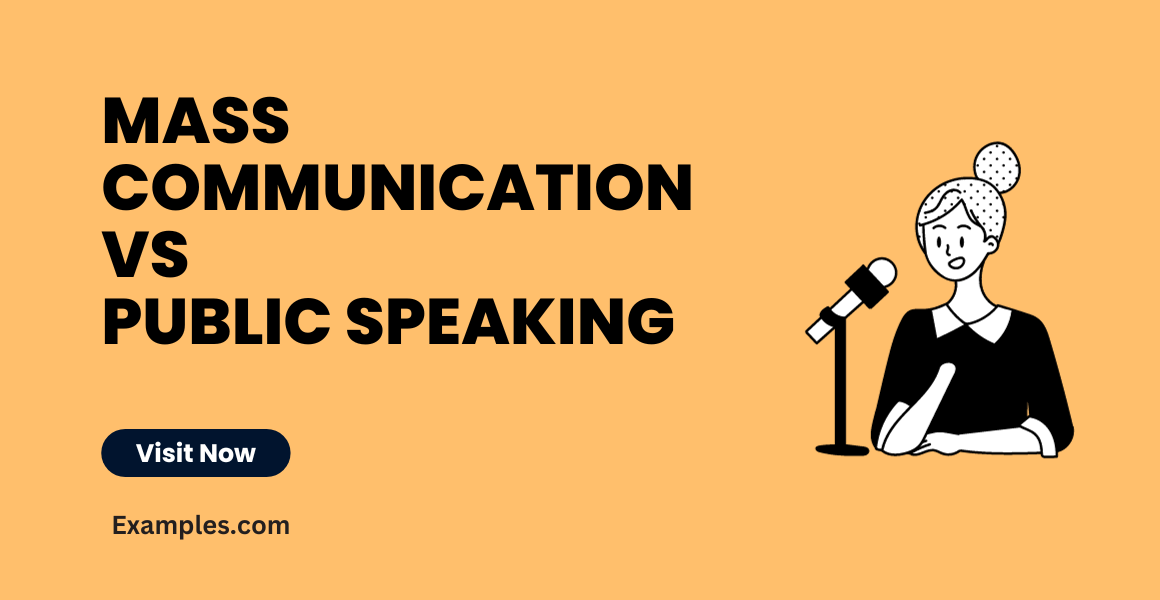Mass Communication vs Public Speaking – 19+ Examples
In the diverse world of communication, distinguishing between Mass Communication and Public Communication is crucial for effective message delivery. This guide provides a comprehensive analysis, enriched with practical Communication Examples, to explore the nuances, methodologies, and impacts of these two forms of communication. Whether you’re a media professional, public speaker, or communication student, this guide offers valuable insights and sentence examples to master the art of both mass and public communication in various contexts.
Difference Between Mass Communication vs Public Speaking
In the realms of Mass Communication and Public Speaking, each serves a unique purpose in the art of conveying information, particularly when we consider Mass Communication Examples in Journalism. This detailed guide, designed to be SEO and NLP friendly, emphasizes the distinct characteristics, goals, and methods of these two communication forms. Presented in a comprehensive table format, it provides an in-depth comparison that highlights the nuances in audience interaction, message delivery, and impact, which are crucial for professionals in journalism, media, public relations, and public speaking.

Comparative Analysis
| Feature | Mass Communication | Public Speaking |
|---|---|---|
| Definition | Involves conveying messages to a large, diverse audience, often through various media like TV, newspapers, and online platforms. | Entails speaking directly to a live audience, typically in a more intimate and interactive setting. |
| Primary Objective | To inform, educate, or entertain a wide audience, often with standardized content. | To persuade, motivate, or inform a specific group, with a more personalized approach. |
| Audience Size and Diversity | Generally large and heterogeneous, covering a broad demographic and geographic spectrum. | Smaller, more homogenous groups, gathered in specific venues or events. |
| Feedback Mechanism | Indirect and delayed, due to the scale and medium of communication. | Immediate and direct, with the ability to gauge audience reactions in real time. |
| Mediums Used | Includes broadcasting, digital media, print publications, and social media platforms. | Utilizes in-person delivery, often supported by visual aids, gestures, and vocal modulation. |
| Message Tailoring | Messages are crafted for mass appeal, targeting general public interest and understanding. | Messages are often customized to the audience’s specific interests, background, and response. |
| Scope of Influence | Can have a widespread influence, shaping public opinion and cultural norms. | Influence is more direct and personal, often leading to immediate impact on the audience. |
| Content Style | Content is designed to capture and retain the attention of a diverse audience, often using multimedia elements. | Content is crafted to engage and connect with the audience on a personal level, using storytelling and rhetoric. |
| Professional Roles | Roles like journalists, media planners, content strategists, and social media managers are involved. | Roles include public speakers, motivational speakers, trainers, and educators. |
| Interaction Level with Audience | Interaction is generally one-way, with limited opportunities for audience participation. | High level of audience interaction, including Q&A sessions, direct feedback, and audience engagement activities. |
20 Examples of Mass Communication vs Public Communication
In the intricate world of conveying messages, Mass Communication and Public Communication stand as two distinct pillars, each with unique strategies and impacts. This section, rich in SEO and NLP-friendly content, highlights 20 unique examples that demonstrate the diverse applications and approaches of these communication forms. From wide-reaching media campaigns to intimate public interactions, these examples offer insights into effective communication techniques suited for different audience sizes and settings. Understanding these differences is crucial for anyone looking to craft messages that resonate with their intended audience, whether through mass media platforms or in personal communication scenarios.
Mass Communication Examples
- Television News Programs: Broadcasting news to a wide audience across regions.How to Communicate: Use clear, engaging narration and visual elements to convey news stories.
- Social Media Advertisements: Brands promoting products on platforms like Facebook and Instagram.How to Communicate: Create visually appealing and concise content that captures the essence of the brand.
- Online News Articles: Digital platforms providing updates and information on various topics.How to Communicate: Write succinct, informative articles with attention-grabbing headlines.
- Radio Advertising: Commercials broadcasted to a regional or national audience.How to Communicate: Develop catchy jingles or narratives that resonate with a broad listener base.
- Film Trailers on YouTube: Movie studios using YouTube to generate buzz for upcoming releases.How to Communicate: Craft compelling previews that highlight key movie themes and elements.
- Podcasts on Current Topics: Podcasts discussing global issues, accessible to a worldwide audience.How to Communicate: Use engaging discussions and expert insights to keep the audience interested.
- Billboard Advertising: Large-scale adverts displayed in high-traffic areas.How to Communicate: Design striking visuals with minimal text for quick audience comprehension.
- Email Newsletters: Companies sending regular updates to their subscribers.How to Communicate: Provide valuable content that is both informative and engaging.
- Public Health Campaigns on Multiple Platforms: Using TV, radio, and online mediums to spread health awareness.How to Communicate: Disseminate clear, actionable health messages across various platforms.
- National Public Service Announcements: Government messages broadcasted to inform the public on national concerns.How to Communicate: Deliver straightforward, authoritative messages to instill public awareness and action.
Public Communication Examples
- Local Community Meetings: Discussions on community issues with local residents.
How to Communicate: Foster open dialogue, addressing concerns and encouraging community input. - Workplace Team Briefings: Managers communicating updates and objectives to their teams.
How to Communicate: Speak clearly, ensure understanding, and invite feedback. - University Lectures and Seminars: Professors teaching and interacting with students in an academic setting.
How to Communicate: Combine expertise with an engaging presentation style to educate and inspire students. - Public Speaking Events: Keynote speakers addressing audiences at conferences or events.
How to Communicate: Use compelling storytelling and audience engagement techniques. - Public Debates: Individuals discussing different viewpoints in front of an audience.
How to Communicate: Present arguments clearly and respond thoughtfully to counterpoints. - Professional Networking Events: Face-to-face interactions with industry peers for building professional relationships.
How to Communicate: Engage in meaningful conversations and listen actively. - Workshops and Training Sessions: Interactive sessions focusing on skill development or knowledge sharing.
How to Communicate: Use hands-on activities and direct communication to enhance learning. - Book Readings and Signings: Authors engaging with readers and fans in intimate settings.
How to Communicate: Read engaging excerpts and interact personally with attendees. - Press Conferences: Organizations addressing the media and public directly on specific issues.
How to Communicate: Offer clear, concise information and answer questions directly. - Motivational Speeches at Schools: Speakers inspiring and educating students through personal stories.
How to Communicate: Connect with the audience through relatable experiences and motivational messages.
Comparison Between Mass Communication vs Public Speaking
In the realm of conveying information and ideas, Mass Communication and Public Speaking serve distinct yet equally important roles. This detailed comparison, optimized with a focus on “Mass Communication Examples in Journalism,” offers a clear distinction between the two. It is crucial for journalists, communicators, and public speakers to understand these differences to effectively tailor their approach, whether addressing a vast audience through various media channels or engaging with an audience face-to-face.
Comparative Analysis
| Feature | Mass Communication | Public Speaking |
|---|---|---|
| Definition | Involves disseminating information to a large audience, typically through media channels like television, radio, and online platforms. | The art of delivering a speech or presentation to a live audience in a structured, deliberate manner. |
| Objective | Aims to inform, educate, persuade, or entertain a broad public audience. | Focuses on engaging and influencing an audience present at the moment, often aiming to inform, persuade, or inspire. |
| Mediums Used | Utilizes mass media tools such as broadcasting, print, digital media, and social media. | Primarily involves face-to-face communication, using verbal and non-verbal cues to convey the message. |
| Audience Reach | Capable of reaching a vast, geographically dispersed audience simultaneously. | Limited to the audience present in the venue or setting, offering a more intimate interaction. |
| Feedback Mechanism | Indirect and not immediate, often through ratings, comments, or social media interactions. | Direct and immediate, visible through audience reactions, questions, and engagement during the speech. |
| Message Personalization | Generalized for mass appeal, addressing a wide range of interests and backgrounds. | Can be more personalized and tailored to the specific audience in attendance. |
| Skills Required | Requires skills in content creation, storytelling, and understanding of various media platforms. | Demands strong public speaking skills, audience analysis, and the ability to engage listeners effectively. |
| Examples in Journalism | News broadcasting, investigative reporting, and news articles on digital platforms. | Press conferences, journalistic interviews, and panel discussions at media events. |
| Professional Roles | Journalists, broadcasters, content creators, and digital marketers. | Public speakers, seminar leaders, motivational speakers, and educators. |
| Impact | Influences public opinion and societal norms on a large scale. | Impacts individual attitudes, behaviors, and can inspire immediate action or change. |
Audience Engagement in Mass Communication vs Public Speaking
Audience engagement, a critical aspect of effective communication, varies significantly between Mass Communication and Public Speaking. Understanding these differences is crucial for communicators, journalists, public speakers, and educators to tailor their approach for maximum impact. This guide explores how audience engagement is achieved and measured in these two distinct communication domains.
Audience Engagement in Mass Communication
Mass Communication involves reaching out to a vast, often diverse audience via multiple channels like TV, radio, and online platforms. Here’s how audience engagement works in this domain:
- Broad and Diverse Audience: Engaging a wide demographic spread across different regions and backgrounds.
- Indirect Interaction: Unlike public speaking, interaction is not immediate. Feedback is gathered through comments, shares, and ratings.
- Content Strategy: Content needs to be compelling and relatable to a wide audience. Utilizing storytelling, visual elements, and relatable scenarios helps in enhancing engagement.
- Digital Analytics: Online platforms provide analytics that offer insights into audience behavior, preferences, and engagement levels.
- Challenges in Engagement: Due to the broad audience scope, personalizing content to increase engagement can be challenging.
- Role of Social Media: Platforms like Twitter and Facebook allow for more direct interaction with the audience through comments and direct messaging.
Audience Engagement in Public Speaking
In contrast, Public Speaking focuses on live, direct communication with an audience, offering immediate engagement opportunities.
- Direct Audience Interaction: The speaker can directly interact with the audience, respond to their reactions, and adjust the speech accordingly.
- Feedback Mechanisms: Non-verbal cues like facial expressions, applause, and verbal feedback provide immediate insights into audience engagement.
- Personalization of Message: Speakers can tailor their message in real-time based on audience reactions, making the engagement more dynamic and effective.
- Audience Participation: Techniques like Q&A sessions, audience polls, and interactive activities enhance engagement.
- Challenges: The speaker needs to be adept at reading the room and managing diverse reactions on the spot.
- Engagement Tools: Storytelling, humor, rhetorical questions, and compelling visuals can significantly increase audience engagement in public speaking.



